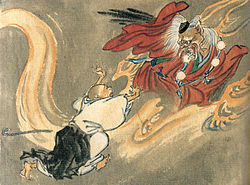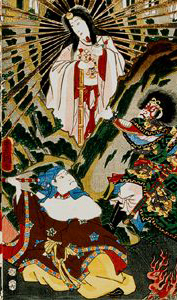Yamabushi (one who lies in the mountains) are Japanese mountain ascetic hermits with a long tradition, endowed with supernatural powers in traditional Japanese mysticism. They follow the Shugendō doctrine, an integration of mainly esoteric Buddhism of the Shingon sect, with Tendai Buddhist, Taoism, and Shinto elements. For the most part solitary, they did form loose confederations, and associations with certain temples, and also participated in battles and skirmishes alongside samurai and sōhei warrior monks on occasion. Their origins can be traced back to the solitary Yama-bito and some hijiri of the eighth and ninth centuries.There has also been cross-teaching with samurai weaponry and Yamabushi’s spiritual approach to life and fighting.
In modern use, the term ubasoku-yamabushi refers to laymen practitioners of shugendō. The religion places a heavy emphasis on asceticism and feats of endurance, and white and saffron-robed yamabushi toting a horagai conch-shell trumpet are still a common sight near the shugendō holy site of Dewa Sanzan and in the sacred mountains of Kumano and Omine.


